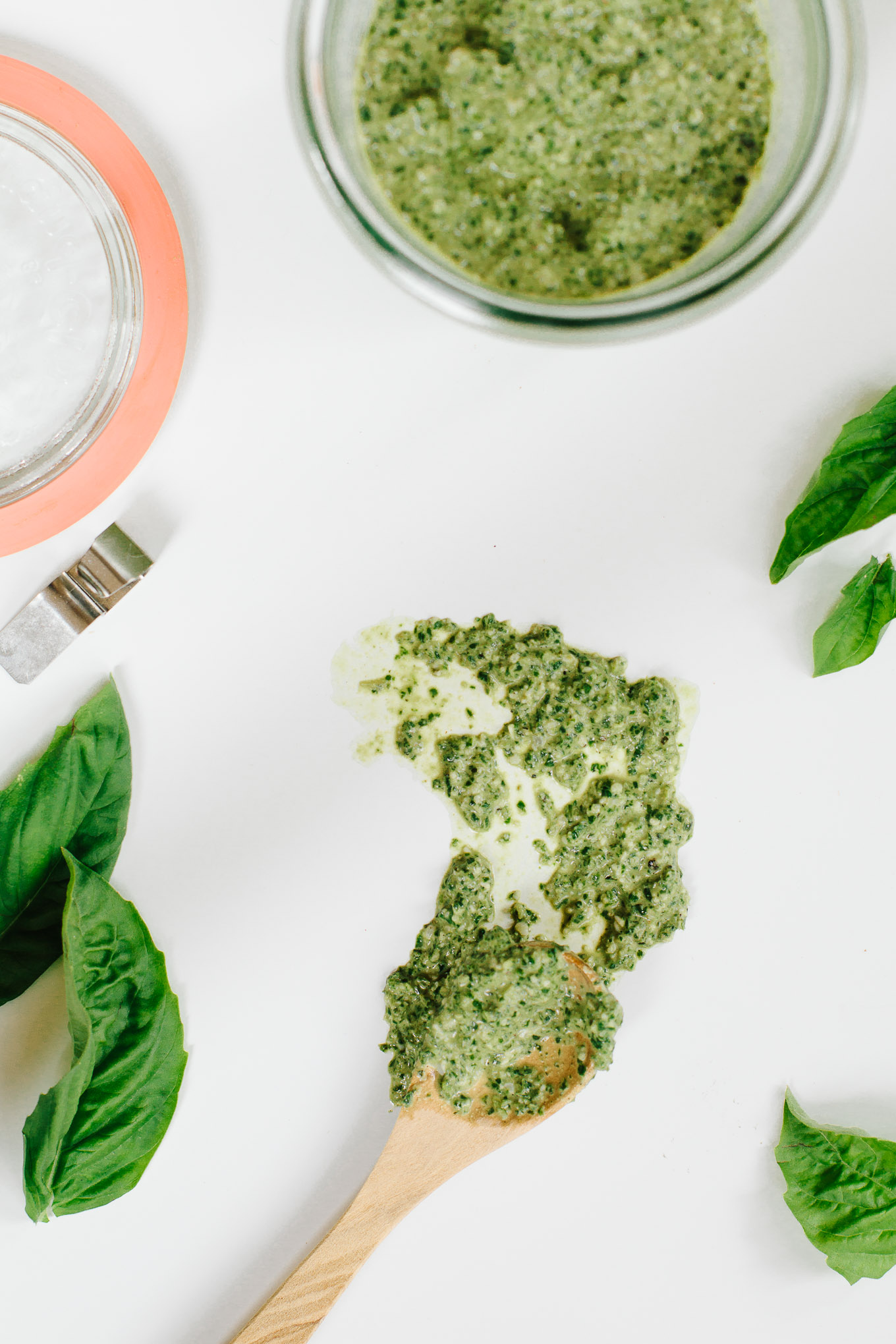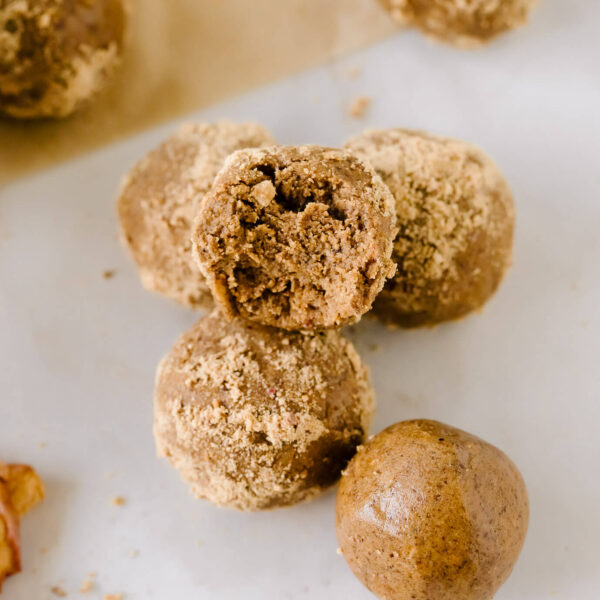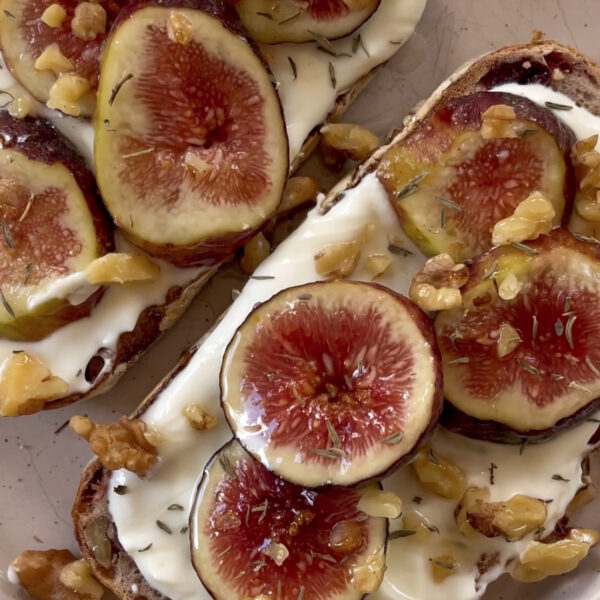Along with summer comes an abundance of fresh herbs that can elevate any dish with their bright flavor. While fresh herbs can be accessed year round, purchasing or harvesting fresh herbs in the midst of peak growing season ensures the best flavor and nutrition (just like other produce!). I love keeping fresh herbs on hand to ensure a bright and flavorful meal. While you could easily just top your dish with the fresh herbs, making a simple sauce is a great way to preserve the delicate herbs and extend their shelf life. There are endless ways to incorporate herbs into homemade condiments, but this hemp seed basil pesto is by far one of my favorites. It’s easy and versatile! If you have never made pesto before, I promise you it is incredibly simple and takes only 5 minutes.
Hemp seed basil pesto
Today I’m sharing my take on traditional pesto. This hemp seed basil pesto is a dairy-free, vegan spin on traditional basil pesto that gets a boost of nutrients from hemp seeds. Traditional pesto is made up of basil, pine nuts, olive oil, garlic and Parmesan cheese. It’s bright, pungent and can easily be the shining star or play a supporting role in an endless variety of dishes. This hemp seed basil pesto keeps a similar flavor profile of traditional basil pesto but with the substitution of hemp seeds for the pine nuts and omission of the Parmesan cheese. The recipe gives you the option of nutritional yeast to impart that cheesy, umami flavor but if it is not one of your pantry staples, it is not essential.
While I love this hemp seed basil pesto combination, I encourage you to be creative in the kitchen, use what you have on hand and customize you your taste preferences. One large aspect of my mission with Nourished by Nutrition is helping empower you to feel confident about your health and nutrition choices, and along with that comes feeling confident in the kitchen. So today I’m also sharing with you a guide to making homemade pesto. Below is a simple formula of ingredient ratios and suggestions on flavor combinations. I hope you find this pesto guide helpful!
Below is a simple guide to making homemade pesto. It’s a rough formula of ingredient ratios and suggestions on flavor combinations. I hope you find this pesto guide helpful and get experimenting!



Simple Guide to Making Pesto
The Ingredients
Greens – Tender herbs and lefty greens can be to make up the bulk of the pesto, all with subtle flavor variations. And you don’t have to stick to only one herb or green. Mix and matching will create a more unique pesto!
Try: Parsley, cilantro, mint, arugula, kale, collard greens, mustard greens, radish tops, beet greens, carrot tops, spinach, watercress, broccoli, peas, etc.
Nuts/seeds – nuts and seeds provide the buttery flavor and earthiness to the pesto. Plus, different nuts and seeds have different nutrient profiles. Mixing it up will help you get a wide variety of different healthy fats, vitamins and mineral.
Try: Hemp seeds, cashews, almonds, walnuts, macadamia nuts, pistachios, sunflower seeds, pumpkin seeds, etc.
Oil – I cannot stress enough the importance of high-quality oil. Steer clear of vegetable oils and opt for olive oil, avocado oil or other nut or seed oil like flax, walnut, or pumpkin.
Try: Olive oil, avocado oil, flax seed oil, pumpkin seed oil, walnut oil, hemp oil, MCT oil, etc.
Flavor – Lemon, garlic, salt and pepper is all you really need!
Cheese/nutritional yeast (optional) – Some might argue with me here, but in my opinion, cheese is optional. Based on your dietary preference you can choose to include it or not. If you have nutritional yeast on hand, adding 1-2 tablespoons will impart a cheesy, umami flavor and an extra boost of nutrients.
Try Nutritional yeast, or your favorite hard cheese like Parmesan, Romano, Asiago, etc.
Basic Pesto Formula
2 cups greens + 1/4 cup nuts/seeds + 1/4 cup oil + 2 T lemon + 1 clove garlic + (optional – 1 -2 T nutritional yeast or hard cheese)
This is a very general ratio guide to pesto. Slight adjustment to the ratios will not have that much of an impact of the overall product. So use this as a guideline and find out what works best for you!
How to Blend
You will need either food processor or blender to get the job done. While you can just toss everything in the food processor or blender, I’ve found adding the ingredients in stages and pulsing them together to form a thick paste*. If you are a visual learner The Kitchn has an amazing post and quick video tutorial.
*Once you have a paste made you can simply add more oil or water to thin before serving
How to Store
Pesto will oxidize (turn brown) after being exposed to air for a while. While this isn’t harmful, it’s not very appetizing. To reduce the browning store in the fridge with a light layer of olive oil or water on top. Pesto keeps in the fridge for about 5 days.

How to use Pesto
While pesto can be a sauce or a main ingredient in a recipe, it can also be used just a flavor enhancer or garnish just as you would use fresh herbs. Here are some suggestions for using up your jar of pesto, but I encourage you to get creative!
- Sauce for pasta (Banza is my favorite!) or pizza
- Alternative to a mayo-based pasta salad
- Drizzled on tomatoes for a quick side dish (top on toast for a quick bruschetta!)
- Mix with hummus
- Spread on a sandwich
- Drizzle on eggs
- Toss with white beans
- Mix into quinoa or other grain
- Add some apple cider vinegar to make a dressing
Freezing Pesto
If you have an abundance of fresh herbs you can always make a double or triple batch of pesto then freeze it so you have pesto at your convenience. The best way to freeze pesto is with an ice cube tray.
Once frozen you can pop the cubes out and store them in a container or freezer safe bag for easy access. When you are ready to use you the pesto, take out as many cubes as you need and let them thaw at room temperature or heat them slightly over the stove or in the microwave. Pesto can keep in the freezer for 3 months.





[…] Pesto with pumpkin and flax seeds […]
[…] Pesto with pumpkin and flax seeds […]
[…] to try: Hemp seed basil pesto, Adaptogen Snack Balls, Strawberry Baked Oatmeal with Hemp […]